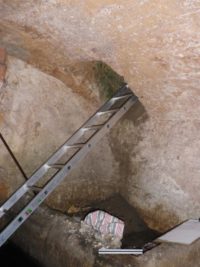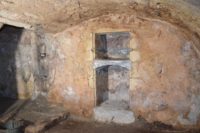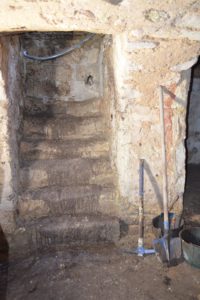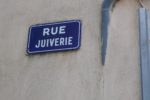 Saint-Paul-Trois-Châteaux, an ancient city in southeastern France that boasts a splendid 12th century Romanesque church, medieval town walls and gates and a cobblestoned downtown of considerable charm, can also lay claim to unique vestiges of a small Jewish community that abided there for three centuries or so before the saw the anti-Semitic writing on the all and got out while the going was good.
Saint-Paul-Trois-Châteaux, an ancient city in southeastern France that boasts a splendid 12th century Romanesque church, medieval town walls and gates and a cobblestoned downtown of considerable charm, can also lay claim to unique vestiges of a small Jewish community that abided there for three centuries or so before the saw the anti-Semitic writing on the all and got out while the going was good.
There was a small but consistent population of Jews in the city from the 12th century well into the 15th. They were ghettoized into a handful of streets on and around the Rue Juiverie, the street that is still named after them centuries after their departure. As was the custom with these segregated neighborhoods, the residents had a curfew and were locked in at night. Still, bounded on one side by the town market and on the other by bishop’s palace, the Jewish quarter was in the very heart of the city and the 70 or so families who lived there made good.
 We know there was a synagogue in the neighborhood because a 15th century Holy Ark was found in one of the buildings, known as Tower House, in the early 18th century. Dated 1445, the stone archway with wooden doors was where the synagogue’s Torah scrolls were kept. It is a unique survival, the only one of its kind in France and is now on display in the local archaeological museum.
We know there was a synagogue in the neighborhood because a 15th century Holy Ark was found in one of the buildings, known as Tower House, in the early 18th century. Dated 1445, the stone archway with wooden doors was where the synagogue’s Torah scrolls were kept. It is a unique survival, the only one of its kind in France and is now on display in the local archaeological museum.
To the marked advantage of the Jewish community, the town wasn’t part of France in the Middle Ages. It was ruled by the Holy Roman Empire, so yes,while they were locked in at night and subject to a number of discriminatory laws and practices, at least they didn’t have to deal with repeated expulsions, confiscations and a wide variety of oppressive measures ordered by French kings like Philip II, who was just 17 years old when he kicked out the Jews and stole their stuff in 1182, and Louis IX who set copies of the Talmud on fire by the thousands, made usury illegal and forced Jews charged with the newly criminal offense to pay huge sums in support of the Crusades and turned the Inquisition up to 11. They even managed to dodge the mass expulsion edict of 1394 when all the Jews in France were forced to leave the country by order of King Charles VI.
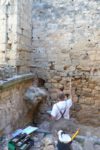 Provence was absorbed into France in 1481. Initially it seemed like Jews in the province, which had deeply rooted Jewish communities going back to the 1st century A.D., might be okay. Their privileges were confirmed in 1482. But de jure and de facto are two very different things, and in 1484 waves of anti-Semitic violence broke out regularly. Provencal Jews, recognizing the stench of pogrom approaching, starting packing up and leaving, and the Jews of Saint-Paul-Trois-Châteaux were no exception. Archival records note there were just three Jewish families left in town by 1486, and that’s the last mention of any Saint-Paul-Trois-Châteaux Jews on the historical record.
Provence was absorbed into France in 1481. Initially it seemed like Jews in the province, which had deeply rooted Jewish communities going back to the 1st century A.D., might be okay. Their privileges were confirmed in 1482. But de jure and de facto are two very different things, and in 1484 waves of anti-Semitic violence broke out regularly. Provencal Jews, recognizing the stench of pogrom approaching, starting packing up and leaving, and the Jews of Saint-Paul-Trois-Châteaux were no exception. Archival records note there were just three Jewish families left in town by 1486, and that’s the last mention of any Saint-Paul-Trois-Châteaux Jews on the historical record.
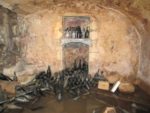 In the 1990s, the city government began to buy properties in the old Jewish quarter with an eye to restoring it and creating a suitable environment to return the Holy Ark to its original context in the Tower House. Archaeologists have been studying the neighborhood since 2014 and have discovered remains going back to Gallo-Roman times. The most recent work has unearthed a flooded cellar that archaeologists believe was a mikveh, a ritual Jewish bath. The city called in experts from France’s National Institute for Preventive Archaeological Research (INRAP) to explore this intriguing find.
In the 1990s, the city government began to buy properties in the old Jewish quarter with an eye to restoring it and creating a suitable environment to return the Holy Ark to its original context in the Tower House. Archaeologists have been studying the neighborhood since 2014 and have discovered remains going back to Gallo-Roman times. The most recent work has unearthed a flooded cellar that archaeologists believe was a mikveh, a ritual Jewish bath. The city called in experts from France’s National Institute for Preventive Archaeological Research (INRAP) to explore this intriguing find.
This small (7 by 4 meters), vaulted and partially buried construction contains a groundwater emergence point. The bath would have consisted of a shallow pool. The construction forms and techniques could correspond to the configurations of Medieval mikvaots.
The building has since been modified several times. The cellar was used to store bottles, for example (the archaeologists collected more than 600 of them), and anomalies suggest a later, more complex, modification. A diverticulum and the existence of a walled, partially masked, opening suggest architectural alterations that were masked by later transformations. They could be the remains of spaces associated with the mikveh and necessary for its functioning (dressing room, stairway access, etc…).
